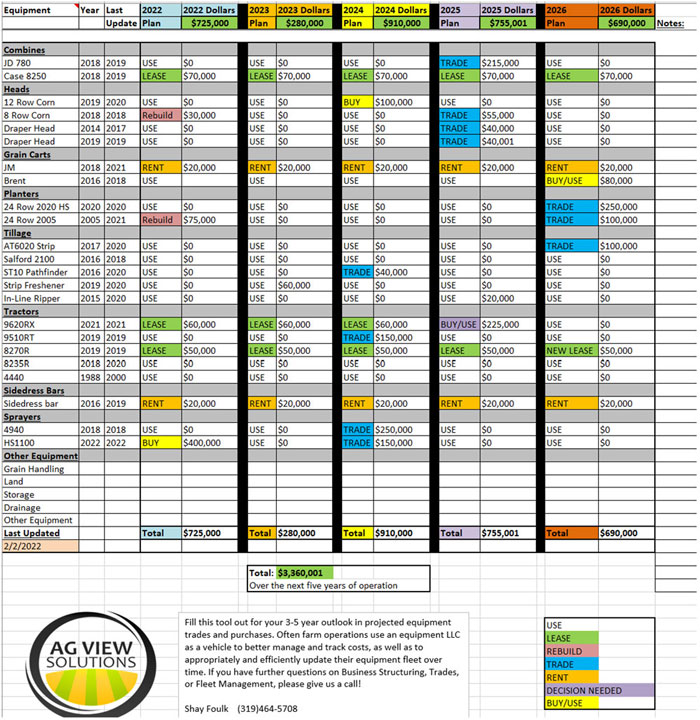The airline industry rolls out new airplanes with an anticipated life expectancy. Some aircraft are designed for 15-20 years of heavy use, while others are designed for much longer periods of time; 80-100 years. This evaluation is made based on estimated miles, conditions, environments, and specific uses. Why then, do we do such a poor job of handling our farm equipment the same way?
Farm equipment purchasers and dealers often treat the relationship as though they are on different teams. The farmer views the dealers as trying to make as much money as possible, and the dealer thinks the farms are often only in it for the savings and the next “deal.” Somewhere between two sides of a story is the truth. That truth is farmers want good products at a reasonable price (to be addressed in the next article) and dealers want to help an operation be successful and utilize quality equipment.
Unfortunately, in the chaos of the discrepancies that normally occur, proper equipment management, like in the airline industry, is put on the back burner. Sometimes equipment is traded sooner than it needs to be, and sometimes farm businesses hang onto equipment that may not fit their needs any longer in the hopes of saving dollars.
Long-term equipment management success will require more deliberate, involved, and data-driven decision-making processes in the next 5-10 years. I’m confident that the dealers and farmers who adopt this mentality will be the ones continuing to farm in 20 years.
Specifically, dealers will need to focus on these 8 areas:
- More (and Better) Service
- Market Value Equipment Appraisals
- 3-5 Year Equipment Outlook
- Proactive Equipment Management and Suggestions
- Rate Management in Cost/Acre
- Better Understanding of Farm Operations
- Margin Enhancement
- Lease Management
This article focuses on the “3-5 Year Equipment Outlook Tool” you’ve gotten a glimpse of a few times.
First, let me outline the major points of discussion in utilizing a 3–5-year equipment outlook:
- Having a plan in place on equipment trades and purchases
- An open discussion on dollars needed to accomplish trades and purchases
- Generating dialog on farm business changes
- Timely decision-making
- Making adjustments and being flexible
The tool you see in front of you is a simple, yet powerful spreadsheet. It maps out primary power units and pieces of equipment needed in an operation but doesn’t overcomplicate the sheet with too much information.
Request the tool by clicking this link
It evaluates the next 5 years in an operation, whether the owners truly know their decisions that far out or not. This sheet helps visualize the long-term strategy and makes it very apparent on the dollar management needed. Basically, you input all the current or soon-to-be-added equipment, enter the dollar amount needed to make those changes, and it auto-sums the capital requirements. It also maps out costs over the next several years in a “Total” category. Simple? Yes. Powerful? Very.
1. Having a Plan in Place on Equipment Trades & Purchases
Gone should be the days of making last-minute, unexpected purchases at year-end to better manage tax consequences. While it may help the farmer, and provide quality income (some years) for the dealer, how much better off would you be in managing the business if you had a better projection and idea of revenue, trades and inventory management? Putting this plan in place is great for all parties. It forces the farmer or equipment owner to think about when they might need to trade, generates discussion and puts some ideas on paper.
2. An Open Discussion on Dollars Needed to Accomplish Trades & Purchases
Most good things come with a cost and equipment is no exception. It’s no secret that equipment prices have risen significantly (14-19%, minimum, in most farms we work with), and we need to better manage those dollars. We can generate a much better conversation than just worrying about why this occurred by addressing how to manage the capital required to upgrade as needed. Now, to reduce the liability, you should obviously make the customer aware that these are best guesses and estimates, and that you are working with the best information you have available at the time. (If you need to add a little disclaimer on the worksheet and sign off on it internally, it might not be the worst idea -- I’ll leave you to run your business how you see fit.)
If you can tell a customer that the upgrades, changes, leases, rentals and improvements they are looking to make in 2022 would cost nearly $700,000, it reduces the sticker shock when it comes time to make the changes. It helps them have a discussion with their lender, if needed and to budget appropriately. Every farmer and equipment owner has the Big Three, as we call it: wants, needs and wishes. Sometimes the capital covers all of them, and sometimes it covers part of one of them.
Being open and honest builds rapport the customer, reduces surprise and shock and adds value to the work you do with their business.
3. Generating Dialog on Farm Business Changes
Change can happen incredibly fast, or incredibly slow. As a dealer, you are at risk of being caught in the unknown with either one of them. Is a transition to a younger equipment manager going to occur in the farm operation? Who is making maintenance and trade decisions? Two more important questions – who influences equipment decisions? What are your expectations of our dealership?
The number one reason customers leave is unmet expectations and lack of dialog. While I don’t agree with the attitude behind it (“Isn’t that the dealer’s job?”), not many farmers do a great job of approaching conflict or letting people know their expectations are not being met. When this happens, they go silent. Silence may seem OK until something trips the fuse, and then what? They go violent! Yelling, frustration and anger come to the surface during busy seasons, breakdowns and when it’s time to write the check for equipment changes.
These issues can be avoided through open dialog. An equipment outlook tool and plan can give you the right opportunity to discuss these items on a regular (at least annually) basis.
4. Timely Decision-Making
I already touched on avoiding some of the year-end tax-planning chaos (sorry folks, it’ll never completely go away.) What I mean by timely decision-making is more related to inventory management, ordering and dealing with long-term planning.
Imagine this scenario. Farmer Dan who you work with fills out a 3-5 Year Equipment Outlook Plan with you. You know he is looking for a used 300 hp tractor for next year, because they are buying a strip-till unit and want capacity to cross-load the work. Both purchases are news to you, by the way! But you’ve made a touchpoint and can now get to work for your customer, which is exactly what they expect of you, and you now have time to do it. You watch closely for a good unit and can get one ordered or bought for them. You were able to save time and money (for you and the customer) because you got a better deal and were able to map out freight and unit transfers well in advance.
At the same time, Farmer Jane also filled out a 3–5-year Equipment Outlook Plan, and she is looking for a used 250 hp tractor for field cultivating and to upgrade her current aged machine. By coordinating and verifying, you already have that tractor sold to the next customer, before the new tractor for Farmer Dan even arrives.
This is somewhat of an oversimplified story, and you do this already. But how much better would you be if you had a Standing Operating Procedure (SOP) like the 3-5 Year Equipment Outlook to keep updated with the businesses you work with?
5. Making Adjustments & Being Flexible
Sometimes things just go to hell in a handbasket. Crop failures, unexpected costs, maybe the farmer accidentally buys a boat … stuff happens! The 3-5 Year Outlook is not designed as a final say or end-all be-all. It is a supplement and catalyst for good communication, open dialog and a value-add from your dealership to the customer.
What might adjustments look like? Different units, shifting capital purchases from one year to the next (sometimes forward, not always further down the road!), or simply removing items as the operation changes. A business that is willing to work closely in times of rapid change will be adapted to the expectations from the customer in the future.
Final Notes on the 3-5 Year Equipment Outlook
- Progressive farmers are going to expect this out of you and your dealership in the future. Test-run it with your key accounts and explain that this is to provide better value and service to them for the years ahead. Refine the discussion, build it into an SOP, and start implementing it with the other customers. It’s not going to be a fit for everyone, and some farmers just won’t care or won’t want to do the work -- that’s OK! It’s as important for them to know who they want to hitch their wagon to as it is for you to know who you want to hitch your wagon to for the long ride. Regardless, it shows that you are making the effort and providing value as well.
- Don’t overcomplicate the tool. It’s not perfect, but we’ve found that when you start adding too many variables, it gets overwhelming. They key here is the unit, cost and long-term plan. Things like hours, serial numbers, use history, etc. can be stored in a supplementary sheet, and will also be found in another tool I will be sharing in a supplementary article down the road -- stay tuned. Also, make sure it prints on one page.
- Don’t just send it out and ask them to fill it out -- that’s lazy and will probably have the opposite intended effect.
This is a powerful tool that is easy to use and provides a tremendous amount of value to your customer. Take them to implement it effectively, and put yourself ahead of the competition, and be in front of the coming changes your customers expect of you.
Request the tool by clicking this link
I look forward to diving further into the other 7 topics listed and providing more tools and resources for your business. I am always available for questions and discussion, and for speaking and coaching with your dealer team. We have a host of business decision-making tools available for your business and farm operations, so don’t be afraid to ask if you have specific questions!
Coming Next: Calculating Margin Enhancement on Farm Equipment
Part 1: The 3-5 Year Equipment Outlook Tool
Part 2: Calculating Margin Enhancement on Farm Equipment
Part 3: Equipment Rates Built for Individual Farms & Equipment Companies








